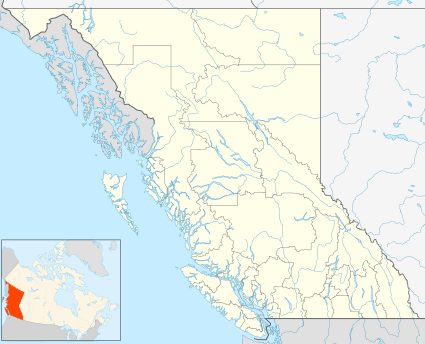Royal Jubilee Hospital
The Royal Jubilee Hospital is a 500-bed general hospital in Victoria, British Columbia, Canada located about 3 km (1.9 mi) east of the city centre, in the Jubilee neighbourhood (itself named after the hospital).
| Royal Jubilee Hospital | |
|---|---|
| Island Health | |

| |
 Location in British Columbia | |
| Geography | |
| Location | Victoria, British Columbia, Canada |
| Coordinates | 48.4334°N 123.3274°W |
| Organization | |
| Care system | Public Medicare (Canada) |
| Type | General |
| Affiliated university | University of British Columbia |
| Services | |
| Emergency department | Yes |
| Beds | 500 |
| Helipad | TC LID: CBK8 |
| History | |
| Opened | 1890 |
| Links | |
| Website | Royal Jubilee Hospital |
| Lists | Hospitals in Canada |
Overview
Its name commemorates the Golden Jubilee of Queen Victoria in 1887. Founded in 1890, Royal Jubilee was Victoria's main hospital until 1983, when an expanded Victoria General Hospital re-opened in the suburban municipality of View Royal.[1] Royal Jubilee offers critical-care, surgery, diagnostics, emergency facilities and other patient programs. It has a particular focus on cardiac medicine.[2]
In 2007, the British Columbia government announced that it would expand and renovate the hospital, increasing the number of beds to 500 and replacing many buildings.[3] The new 500-bed patient care centre (PCC) was opened to the public in early 2011.
Campus Map
See BC Cancer Agency for a map of the grounds with parking and buildings shown.[4] Island Health also hosts a PDF campus map for the Royal Jubilee Hospital, as well as the variety of services offered at RJH.[5]
Begbie Hall
Begbie Hall, a three-storey former nurses' residence at the hospital, was designated a National Historic Site of Canada in 1989 to commemorate the growing professionalism of nursing in the early 20th century and the contribution of nurses to health care in Canada.[6] Today the Begbie Hall is used for administrative offices, and contains the Woodward Theatre for meetings. The Woodward Theatre was apparently the original cafeteria for the resident nurses.[7]
Pemberton Memorial Operating Room
The octagonal Pemberton Memorial Operating Room, completed in 1896, was designated a National Historic Site in 2005. It is an octagonal brick operating room; a rare surviving example of a late 19th-century surgical facility from the period when hospitals were transitioning from primarily charitable to scientific institutions.[8]
References
- Victoria Hospitals Foundation: Milestones
- University of British Columbia, Department of Orthopaedics: Vancouver Island Health Authority
- Premier Gordon Campbell's Video Gallery: New Royal Jubilee Hospital
- Begbie Hall. Canadian Register of Historic Places. Retrieved 23 October 2011.
- Personal anecdote, current employee. Needs to be confirmed. April, 2014.
- Pemberton Memorial Operating Room. Canadian Register of Historic Places. Retrieved 28 January 2012.